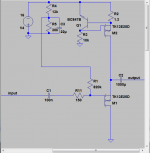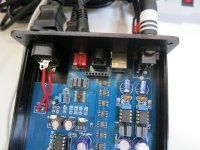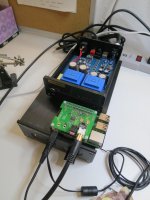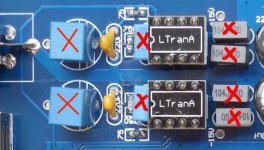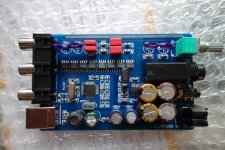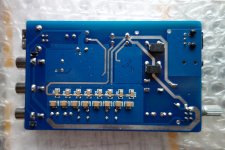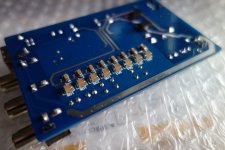I am very curious about the JLH headphone amp - in the description it says its 'single ended classA' but the original JLH 1969 circuit was push-pull, not SE. Clearly this amp has changed output transistors due to the lower power requirement, its possible the design got changed into an SE topology. I shall go in search of a schematic.
I've not experimented with reducing jitter at any of my DACs as I've never noticed a problem - for example between using a DIR9001 or CS8412 and direct I2S coming from a media player or PC.
I've not experimented with reducing jitter at any of my DACs as I've never noticed a problem - for example between using a DIR9001 or CS8412 and direct I2S coming from a media player or PC.
Thank you abraxalito,
Appreciate any suggestions regarding the JLH1969, the amp sounds good to me.
Maybe missing a little "punch". Place to change the transformer to an Antek AS1212.
How do you connect the Raspberry Pi to the TDA1387 8x through I2S ? Found the Dimdim guide
Thank you !
Appreciate any suggestions regarding the JLH1969, the amp sounds good to me.
Maybe missing a little "punch". Place to change the transformer to an Antek AS1212.
How do you connect the Raspberry Pi to the TDA1387 8x through I2S ? Found the Dimdim guide
Thank you !
Last edited:
I had a trawl around but couldn't find the schematic - I did find a few component details though from looking at the pictures of the PCB's silkscreen. Looks to have LM7912/7812 regulators for the supply and TIP41 output transistors. Also one more TO92 device per channel than in the original design.
What headphones are you using with it?
My suggestion to get maximum 'punch' would be to build yourself a true single-ended classA headphone buffer - like this schematic I'm attaching.Its a higher power variant of one I have on my blog. I've built this and its the best headphone amp I've heard, particularly good in terms of 'drive' and 'energy'. I put this down to the extremely good PSRR.
<edit> Ah I see from your .sig that you're using HD650s - they're 300ohm types and will need more gain to get to full level when driven from a DAC. Maybe 6 to 10dB would be sufficient.
What headphones are you using with it?
My suggestion to get maximum 'punch' would be to build yourself a true single-ended classA headphone buffer - like this schematic I'm attaching.Its a higher power variant of one I have on my blog. I've built this and its the best headphone amp I've heard, particularly good in terms of 'drive' and 'energy'. I put this down to the extremely good PSRR.
<edit> Ah I see from your .sig that you're using HD650s - they're 300ohm types and will need more gain to get to full level when driven from a DAC. Maybe 6 to 10dB would be sufficient.
Attachments
Last edited:
If an admin passes by, these 2 images are missing in post #30, because one of the biggest image hostings suddenly decided hotlinking were not allowed(Thanks for destroying the internet) So I will just host them myself.
If anyone is interested in more pictures of the Lee L1387 8x TDA1387 portable DAC, they can be seen in hi-res here.
http://sorbits.dk/i/L1387/


If anyone is interested in more pictures of the Lee L1387 8x TDA1387 portable DAC, they can be seen in hi-res here.
http://sorbits.dk/i/L1387/


Mortenhoe,
I have one. I bought it for work
The best passive filter in my opinion is
220 omh (thinfilm resistor) (stok 576 omh)
3300 pf (stok 4700 pf)
22 omh (stok 22 omh)
220 pf (stok 330 pf)
Next I put the separating capacitor: silmic ce-bp 16v 10uf with parallel 0.1 np0
I have one. I bought it for work
The best passive filter in my opinion is
220 omh (thinfilm resistor) (stok 576 omh)
3300 pf (stok 4700 pf)
22 omh (stok 22 omh)
220 pf (stok 330 pf)
Next I put the separating capacitor: silmic ce-bp 16v 10uf with parallel 0.1 np0
Last edited:
Thank you Abraxalito
Dear Thank Abraxalito,
Thank you for your work on the TDA1387, really enjoying the DAC. Have you compared it to the 9018 or 9028 ? or TDA1541 ?
Have been doing some comparisons:
In order of Sound Quality
Building an amp from scratch is beyond my abilities (someday).
How do I change the TDA1387 x8 from 6 to 10dB for the Sennheiser HD650 ?
All the best,
-Mark
My suggestion to get maximum 'punch' would be to build yourself a true single-ended classA headphone buffer - like this schematic I'm attaching.Its a higher power variant of one I have on my blog. I've built this and its the best headphone amp I've heard, particularly good in terms of 'drive' and 'energy'. I put this down to the extremely good PSRR.
<edit> Ah I see from your .sig that you're using HD650s - they're 300ohm types and will need more gain to get to full level when driven from a DAC. Maybe 6 to 10dB would be sufficient.
Dear Thank Abraxalito,
Thank you for your work on the TDA1387, really enjoying the DAC. Have you compared it to the 9018 or 9028 ? or TDA1541 ?
Have been doing some comparisons:
In order of Sound Quality
1. DT770 250 ohm > JLH 1969 Headphone Amp > TDA1387 x8 DAC > MacBook Pro. Sounds natural and easy, not the largest sound stage, not that largest range, great left / right separation, very musical.
2. DT770 250 ohm > JLH 1969 Headphone Amp > iFi Nano > MacBook Pro. More "digital" sounding, sharper
3. DT770 250 ohm > JLH 1969 Headphone Amp > HiFiBerry DAC+ Pro > Raspberry Pi. Sounds small, not rich, compressed and confused, all the information is there, but not musical.
Also tried all of the above using the Sony MDR-7506, small soundstage, brittle sounding, too close2. DT770 250 ohm > JLH 1969 Headphone Amp > iFi Nano > MacBook Pro. More "digital" sounding, sharper
3. DT770 250 ohm > JLH 1969 Headphone Amp > HiFiBerry DAC+ Pro > Raspberry Pi. Sounds small, not rich, compressed and confused, all the information is there, but not musical.
Building an amp from scratch is beyond my abilities (someday).
How do I change the TDA1387 x8 from 6 to 10dB for the Sennheiser HD650 ?
All the best,
-Mark
I've only compared my TDA1387 DACs to the ES9018K2M in my mobile phone - no competition (except perhaps in the bass). Not heard any of the next generation ESS chips yet.
Your JLH already will have enough gain to feed your HD650s - you'd only need the extra 10dB if you used my suggested MOSFET buffer in place of your JLH.
Your JLH already will have enough gain to feed your HD650s - you'd only need the extra 10dB if you used my suggested MOSFET buffer in place of your JLH.
I just got one of the Taobao TDA1387 x8 DACs, and have been playing with it.
As stock, I was concerned about the big pops on switch on/off, and was hoping there was a neat way to fix that (without doing a full relay circuit).
I removed the stock opamps, replaced with AD845 and removed the 2N2 caps over the opamp output.
This made the pops much worse, and there's often quite noticeable opamp oscillation (in the 15kHz+ region, from a scope at switch on/off. The oscillation ends up in the 1-2MHz region, as the +15/-15V rails collapse.
Any ideas on what to tweak to help reduce the turn on/off pops?
As stock, I was concerned about the big pops on switch on/off, and was hoping there was a neat way to fix that (without doing a full relay circuit).
I removed the stock opamps, replaced with AD845 and removed the 2N2 caps over the opamp output.
This made the pops much worse, and there's often quite noticeable opamp oscillation (in the 15kHz+ region, from a scope at switch on/off. The oscillation ends up in the 1-2MHz region, as the +15/-15V rails collapse.
Any ideas on what to tweak to help reduce the turn on/off pops?
It makes good sense when turning your system on to begin with the source, then the pre- and then finally, the poweramp. When turning off, follow the reverse - begin with the poweramp and end with the source.
Sure, I understand best practice. However sometimes my mains power may fail and restart unexpectedly, and I'd rather not break my amplifier and voice coils because the DAC popped 😛
Most professional DACs don't pop at turn on/off (or just have a very minor pop). Do you know what we can tune to decrease the popping on this DAC?
Most professional DACs don't pop at turn on/off (or just have a very minor pop). Do you know what we can tune to decrease the popping on this DAC?
Removing 2n2 Opamp Feedback Capacitors
Dear Abraxalito,
Thank you for the guidance!
Enjoying the TDA1387. So far have replaced the NE5534 Op-amps with the AD845 op-amps.
Is removing the 2n2 Opamp Feedback Capacitors as simple as just cutting them out ? Do I need to do anything else besides removing them ?
Thank you !
Dear Abraxalito,
Thank you for the guidance!
Enjoying the TDA1387. So far have replaced the NE5534 Op-amps with the AD845 op-amps.
Is removing the 2n2 Opamp Feedback Capacitors as simple as just cutting them out ? Do I need to do anything else besides removing them ?
Thank you !
Attachments
Yes its that simple - just cut them out, or if you have no cutters, wiggle them back and forth like a loose tooth until they fall out.
Too Many Teeth Missing
Dear abraxalito,
I am a fool.
I removed too many, see the photo, I also removed the two closest to the RCA plugs. What are those pieces ?
Thank you !
Yes its that simple - just cut them out, or if you have no cutters, wiggle them back and forth like a loose tooth until they fall out.
Dear abraxalito,
I am a fool.
I removed too many, see the photo, I also removed the two closest to the RCA plugs. What are those pieces ?
Thank you !
Attachments
Hi abraxalito,
I believe they are Phillips 22U 40V Capacitors 030k0, is that correct? I will need to purchase two new ones.
-Mark
I believe they are Phillips 22U 40V Capacitors 030k0, is that correct? I will need to purchase two new ones.
-Mark
No, I think they're not 22uF - they are for coupling so probably 2.2uF. Not very critical in value - 2.2uF or higher value would be fine.
Thank you !!
Thank you abraxalito,
I ordered Phillips 2.2uf 40v, are those correct ?
Funny looks like the capacitors in the TDA1387 are fakes.
No, I think they're not 22uF - they are for coupling so probably 2.2uF. Not very critical in value - 2.2uF or higher value would be fine.
Thank you abraxalito,
I ordered Phillips 2.2uf 40v, are those correct ?
Funny looks like the capacitors in the TDA1387 are fakes.
Those are polarized caps, means we have to figure out which way around to put them in the circuit. I seem to recall that the opamp's output is negative (because the DAC's output current is always positive) by a few volts so put the positive side to the output.
Those are polarized caps, means we have to figure out which way around to put them in the circuit. I seem to recall that the opamp's output is negative (because the DAC's output current is always positive) by a few volts so put the positive side to the output.
Thank you abraxalito,
Negative towards opamp and positive towards output.
You are the best !
Try ECAS http://www.murata.com/~/media/webre.../catalog/products/capacitor/polymer/c90e.ashxThank you abraxalito,
Negative towards opamp and positive towards output.
You are the best !
Sound quality as with black gates.
for example - 22 uF 16 V
You can measure the polarity. As a rule, it is positive from the side of DAC
I ended up with a change in the filterMortenhoe,
I have one. I bought it for work
The best passive filter in my opinion is
220 omh (thinfilm resistor) (stok 576 omh)
3300 pf (stok 4700 pf)
22 omh (stok 22 omh)
220 pf (stok 330 pf)
Next I put the separating capacitor: silmic ce-bp 16v 10uf with parallel 0.1 np0
Attachments
- Home
- diyaudio.com Wiki
- TDA1387 X8 NOS DAC
